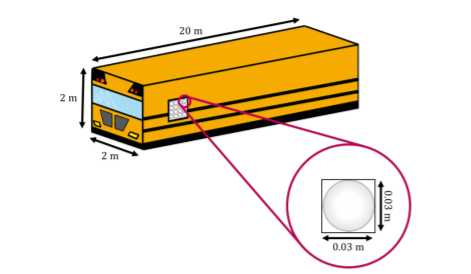2.1: Orders of magnitude
- Page ID
- 19366
Although you should try to fight intuition when building a model to describe a particular phenomenon, you should not abandon critical thinking and should always ask if a prediction from your model makes sense. One of the most straightforward ways to estimate if a model makes sense is to ask whether it predicts the correct order of magnitude for a quantity. Usually, the order of magnitude for a quantity can be determined by making a very simple model, ideally one that you can work through in your head. When we say that a prediction gives the right “order of magnitude”, we usually mean that the prediction is within a factor of “a few” (up to a factor of 10) of the correct answer. For example, if a measurement gives a value of 2000, then we would consider that a model prediction of 8,000 gave the right order of magnitude (it differs from the correct answer by a factor of 4, whereas a prediction of 24,000 would not (it differs by a factor of 12).
How many ping pong balls can you fit into a school bus? Is it of order \(10,000\), or \(100,000\), or more?
Solution
Our strategy is to estimate the volumes of a school bus and of a ping pong ball, and then calculate how many times the volume of the ping pong ball fits into the volume of the school bus.
We can model a school bus as a box, say \(20\:\text{m}×2\:\text{m}×2\:\text{m}\), with a volume of \(80\:\text{m}^{3}∼100\:\text{m}^{3}\).

We can model a ping pong ball as a sphere with a diameter of \(0.03\) m \((3\:\text{cm})\). When stacking the ping pong balls, we can model them as little cubes with a side given by their diameter, so the volume of a ping pong ball, for stacking, is \(∼ 0.00003\:\text{m}^{3}=3×10^{−5}\:\text{m}^{3}\). If we divide \(100\:\text{m}^{3}\) by \(3 × 10^{−5}\:m^{3}\), using scientific notation:
\[\frac{100\:\text{m}^{3}}{3\times\:10^{-5}\text{m}^{3}}=\frac{1\times 10^{2}}{3\times 10^{-5}}=\frac{1}{3}\times 10^{7}\sim 3\times 10^{6}\]
Thus, we expect to be able to fit about three million ping pong balls in a school bus.
Fill in the following table, giving the order of magnitude (in meters) of the sizes of different physical objects. Feel free to look these up on the internet!
| Object | Order of Magnitude |
|---|---|
| Proton | |
| Nucleus of atom | |
| Hydrogen atom | |
| Virus | |
| Human skin cell | |
| Width of human hair | |
| Human | \(1\) m |
| Height of Mt. Everset | |
| Radius of the Earth | |
| Radius of the Sun | |
| Radius of the Milky Way |
- Answer

